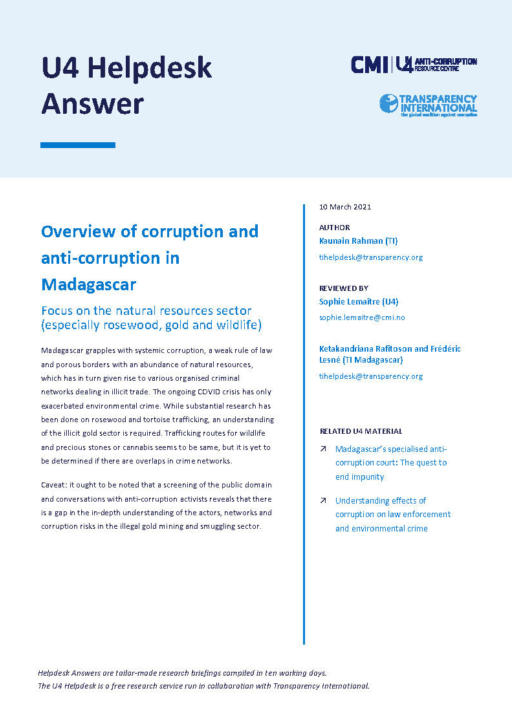
This Anti-Corruption Helpdesk brief was produced in response to a query from a U4 Partner Agency. The U4 Helpdesk is operated by Transparency International in collaboration with the U4 Anti-Corruption Resource Centre based at the Chr. Michelsen Institute.
Query
Please give an update of the Helpdesk Answer on Madagascar and provide an overview of the natural resources sector, the forms of corruption as they relate to the natural resources sector, the corruption risks, actors involved and the mechanisms used in the trafficking of three specific natural resources: rosewood, gold and wildlife.
Summary
Madagascar grapples with systemic corruption, a weak rule of law and porous borders with an abundance of natural resources, which has in turn given rise to various organised criminal networks dealing in illicit trade. The ongoing COVID crisis has only exacerbated environmental crime. While substantial research has been done on rosewood and tortoise trafficking, an understanding of the illicit gold sector is required. Trafficking routes for wildlife and precious stones or cannabis seems to be same, but it is yet to be determined if there are overlaps in crime networks.
Contents
- Background
- Forms of corruption in the natural resources sector
- Focus areas:
a) Rosewood
b) Gold
c) Wildlife - Crime convergence
- Other sectors affected by corruption
- Legal and institutional framework
- Other stakeholders
- References
Main points
- Systemic corruption, weak rule of law and porous borders with an abundance of natural resources has given rise to various organised criminal networks dealing in illicit trade.
- Rosewood is the primary resource being illegally logged and smuggled out of the country, mainly to China. Actors in the trade have strong patronage networks with the political elite, and some rosewood timber barons are politicians.
- While there are several cases of gold smuggling that have come to light, there is a need for further research for an in-depth understanding of the various actors and networks involved.
- Wildlife trafficking is rampant with several species, including tortoises and lemurs being smuggled out of the country via land and sea.
- Harassment of those raising voices against corruption and environmental crime is on the rise.
Caveat
It ought to be noted that a screening of the public domain and conversations with anti-corruption activists reveals that there is a gap in the in-depth understanding of the actors, networks and corruption risks in the illegal gold mining and smuggling sector.
Authors
Kaunain Rahman (TI), [email protected]
Reviewers
Sophie Lemaître (U4), [email protected]
Ketakandriana Rafitoson and Frédéric Lesné (TI Madagascar), [email protected]
Date
22/03/2021

